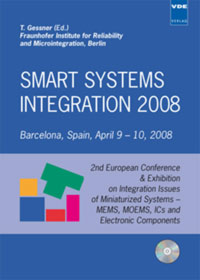Low Power Tracking System for Advanced Health Monitoring
Conference: Smart Systems Integration 2008 - 2nd European Conference & Exhibition on Integration Issues of Miniaturized Systems - MOMS, MOEMS, ICS and Electronic Components
04/09/2008 - 04/10/2008 at Barcelona, Spain
Proceedings: Smart Systems Integration 2008
Pages: 3Language: englishTyp: PDF
Personal VDE Members are entitled to a 10% discount on this title
Authors:
Rouet, Vincent; Venet, Julien (EADS France – Innovation Works, Reliability in Electronics, Suresnes, France)
Abstract:
The environmental data acquisition offers today a broad range of applications such as monitoring system, reliability assessment system or localisation system. This paper describes an electronic device combining and optimising these applications, more particularly but not only in the scope of container monitoring, which can transport complex and expensive goods. The improvements compared to others existing monitoring systems lies mainly in new characteristics (low power, ruggedization to withstand harsh environment) and functionalities (long autonomy, remote control). The electronic system developed in the framework of this study is an advanced Health and Usage Monitoring System (HUMS). It can survey the environment and monitor a device with more than 200 sensors and trigger off alarms thanks to suitable algorithms. These algorithms, based on data fusion, can even perform the assessment of remaining life of the goods. Moreover, the health information of the monitored device can be known remotely and its geographical position can also be provided. All these data can be received by any terminal allowing the reception of SMS (Short Message Service) everywhere in the world. Hence, the HUMS makes the transport of critical goods more reliable and secure, allowing a fast intervention as soon as a warning appears. A HUMS has to be small, but, above all, low power to cover a large application domain. Indeed, since container travels may be long and irregular, the HUMS endurance has been designed for 6- month missions, storing all the data in non volatile memories. Then, these data can be used to trace back the various loads recorded by the sensors and the route followed. In order to be adapted to each application and to ensure the best operating duration by decreasing the power consumption, the HUMS has several possible adjustments linked to the uses of the GPS, the GSM and the sensors.


